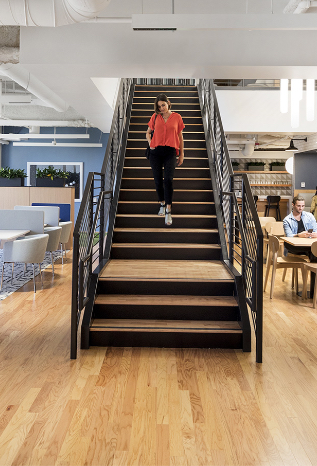Although most of us have become used to dressing down for work in sweatpants and cosy jumpers, there’s actually a good amount of evidence showing that dressing well for work makes you more productive. So whether you’re still working from home, making use of co-working spaces, or heading back into the office full time, it leaves a dilemma: how can you maintain the comfort you’ve been accustomed to over the last couple of years of WFH whilst also ensuring you stay productive and look professional? Let’s take a look.
What to wear to work: does it really impact productivity?
The term ‘enclothed cognition’ was coined in 2012 by Hajo Adam and Adam D. Galinsky, who experimented to show that clothing has an impact on people’s mental processes and the way they’re perceived. The experiment found that participants’ attention increased when wearing a lab coat associated with a doctor, so if you really need to focus on a task, whether you’re in the office or at home, then dressing for the job can help to put you in the right frame of mind. The study supports the idea that we can stay more focused when wearing ‘work clothes’, and our cognitive abilities may be superior to when dressing down.
Anecdotally, this seems to have been the case for many people during the pandemic, although the concept of ‘work clothes’ may have been adjusted slightly to fit with the current situation. Many people appreciate the ritual of getting up and dressed for work in the morning, feeling that it helps them to get in the right frame of mind for the day ahead – but over the last couple of years, sales of comfortable clothing have eclipsed those of office attire, suggesting that people are prioritising comfort over smart dressing.
How did the pandemic change the way we dress for work?
The demand for loungewear and leisure clothing surged by 49% year-on-year from March and April 2019 to 2020, and the demand for tops and t-shirts increased by 13%. The increase in sales could be related to ‘the phenomenon of top dressing’ – that is, wearing a nice top and ensuring your hair and makeup are presentable for video calls, whilst wearing comfortable clothes that can’t be seen on the bottom half.
There doesn’t seem to be any conclusive evidence that dressing up or down for work affects productivity either way. The most important thing is wearing something comfortable that you feel good in. If you feel self-conscious about your clothing or are constantly having to adjust your blouse or pull up your trousers, then it follows that you won’t be as productive as if you were wearing something that you can forget about and simply get on with the job.
How to dress professionally – even for hybrid working
Many employers are now choosing a hybrid work model, where employees can choose to work from home some of the time and spend the rest of their week in the office. This is a great option for both employees and employers, offering a better work-life balance for people who have a long commute, are parents, have other caring responsibilities, or have time-consuming hobbies. It also ensures that those who prefer to work in a face-to-face environment with their colleagues are catered to, and everyone can get together in a meeting room for those sessions that really can’t take place over a video call.
So, how can you ensure you maintain the balance of comfortable clothing for work discovered during the pandemic, along with something a little more business-like for the office? The answer: comfy clothes that look good!
Dress it up, dress it down
It depends on your role, of course. If you’re a lawyer, you’re unlikely to be able to get away with wearing a cosy jumper to work. But if you work in a start-up office, dress codes tend to be far more relaxed – and even better if you have a job with no dress code. Think about layers as the key to making your look work for both professional and casual situations. Wear a smart shirt but throw a cardigan over the top. When you’re just sitting at your desk, you can keep the cardigan on – maybe even add a scarf if it’s cold – and then simply take it off to head into that important meeting.
Can Denim work in the office?
And what about denim? The age-old question is how to wear jeans to work and look professional? Well, the answer again lies in layering, as well as your choice of denim. Generally, it’s best to stick to dark denim for a more professional look. Leave your light washes to the weekend, and go for either indigo or black denim. Layering a blazer over a casual t-shirt, polo neck or shirt will instantly dress it up and make you feel more ‘put together’ for a day in the office.
Look right for the Location
Of course where you work can play a huge role in how you dress as well. If you find yourself working in a major city such as London or Birmingham the majority of offices, especially centrally, often have a very corporate dress code. In contrast to that more rural areas, where business premises are less densely packed, are usually more relaxed over the dress code.
Whatever you wear to work, make it work for you – and the same goes for your office space. Whether you’re an employer looking for a new space for your team, or an entrepreneur who loves the buzz of a co-working space, compare prices at Easy Offices and choose the terms that suit you.

